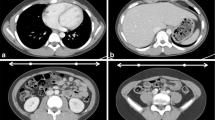Abstract
Greater than 10% of diagnostic imaging studies performed in developed countries are CT examinations. In the United States, as many as 60 million CT studies are performed each year, up to 7 million of which are performed in pediatric patients. In the spirit of the ALARA principle, both adult and pediatric radiologists should strive to decrease pediatric radiation exposure whenever possible. This can be achieved by utilizing imaging studies that do not require the use of ionizing radiation, thus decreasing the number of CT studies performed. If a CT study is indicated, the delivered dose should be optimized to use the lowest possible dose level while still answering the clinical question.
Similar content being viewed by others
References
Verdun FR, Bochud F, Gudinchet F et al (2008) Quality initiatives* radiation risk: what you should know to tell your patient. Radiographics 28:1807–1816
Brenner DJ, Hall EJ (2007) Computed tomography—an increasing source of radiation exposure. New Engl J Med 357:2277–2284
Brody AS, Frush DP, Huda W et al (2007) Radiation risk to children from computed tomography. Pediatrics 120:677–682
Townsend BA, Callahan MJ, Zurakowski D et al (2010) Has pediatric CT at children’s hospitals reached its peak? AJR 194:1194–1196
Slovis TL (2002) The ALARA concept in pediatric CT intelligent dose reduction. Pediatr Radiol 32:219–220
National Council on Radiation Protection and Measurement (2010) Ionizing radiation exposure of the population of the United States. Report NCRP 160. NCRPM, Washington, D.C
Smith-Bindman R, Miglioretti DL, Larson EB (2008) Rising use of diagnostic medical imaging in a large integrated health system. Health Aff (Millwood) 27:1491–1502
Boone JM, Geraghty EM, Seibert JA et al (2003) Dose reduction in pediatric CT: a rational approach. Radiology 228:352–360
McCollough CH, Bruesewitz MR, Kofler JM (2006) CT dose reduction and dose management tools: overview of available options. Radiographics 26:503–512
Wilting JE, Zwartkruis A, van Leeuwen MS et al (2001) A rational approach to dose reduction in CT: individualized scan protocols. Eur Radiol 11:2627–2632
Kalra MK, Maher MM, Toth TL et al (2004) Techniques and applications of automatic tube current modulation for CT. Radiology 233:649–657
Strauss KJ, Goske MJ, Kaste SC et al (2010) Image Gently: ten steps you can take to optimize image quality and lower CT dose for pediatric patients. AJR 194:868–873
Primak AN, McCollough CH, Bruesewitz MR et al (2006) Relationship between noise, dose, and pitch in cardiac multi-detector row CT. Radiographics 26:1785–1794
Gies M, Kalender WA, Wolf H et al (1999) Dose reduction in CT by anatomically adapted tube current modulation: Simulation studies. Med Phys 26:2235–2247
Kalender WA, Wolf H, Suess C (1999) Dose reduction in CT by anatomically adapted tube current modulation: phantom measurements. Med Phys 26:2248–2253
Haaga JR, Miraldi F, MacIntyre W et al (1981) The effect of mAs variation upon computed tomography image quality as evaluated by in vivo and in vitro studies. Radiology 138:449–454
McCollough CH (2005) Automatic exposure control in CT: are we done yet? Radiology 237:755–756
Li J, Udayasankar UK, Toth TL et al (2007) Automatic patient centering for MDCT: effect on radiation dose. AJR 188:547–552
Donnelly LF, Emery KH, Brody AS et al (2001) Minimizing radiation dose for pediatric body applications of single-detector helical CT: strategies at a large children’s hospital. AJR 176:303–330
Kim J, Newman B (2010) Evaluation of a radiation dose reduction strategy for pediatric chest CT. AJR 194:1188–1193
Disclaimer
The supplement this article is part of is not sponsored by the industry. Dr. Callahan has no financial interest, investigational or off-label uses to disclose.
Author information
Authors and Affiliations
Corresponding author
Rights and permissions
About this article
Cite this article
Callahan, M.J. CT dose reduction in practice. Pediatr Radiol 41 (Suppl 2), 488 (2011). https://doi.org/10.1007/s00247-011-2099-y
Received:
Revised:
Accepted:
Published:
DOI: https://doi.org/10.1007/s00247-011-2099-y




